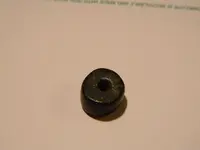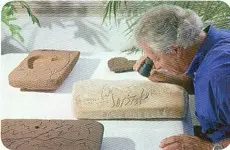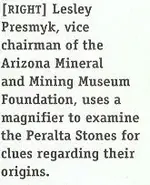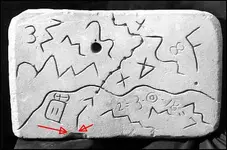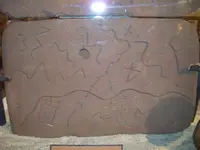gollum
Gold Member
- Joined
- Jan 2, 2006
- Messages
- 6,770
- Reaction score
- 7,728
- Golden Thread
- 0
- Location
- Arizona Vagrant
- Detector(s) used
- Minelab SD2200D (Modded)/ Whites GMT 24k / Fisher FX-3 / Fisher Gold Bug II / Fisher Gemini / Schiebel MIMID / Falcon MD-20
- Primary Interest:
- All Treasure Hunting
- #1
Thread Owner
Okay,
So as not to hijack anybody else's thread with this very large picture montage, I have started this.
Background:
When Desert Archaeology Inc, examined the stone maps, one of the things they said they found in the resultant article in Arizona Highways Magazine was:
and in a subsequent email:
I can say that I have had just as close an examination of the stones as DAI, and I don't see what they are talking about. I have hundreds of hi resolution photographs of almost every detail, and I have yet to see any "start dimples". I also asked the nice folks at DAI just what would be the visible difference between an electric drill dimple and a hand drill dimple? No answer to this day (because there is no difference). I also asked them a simple question as to how a machine sanded surface would look different from a hand sanded one. Same result as my previous question.
While I don't see any "start dimples", I do see that most of the lines on the stones get shallower and shallower as they reach an endpoint. To me, it looks more like the lines were scratched into the surface with a knife blade or similar metal object. You can see in several places where the engraving tool came out of the groove and left a mark outside the line. Also in some spots, you can see where there two or three lines inside a single large groove. Does that sound like a drill or router? NO, it sounds more like someone going over and over the same groove with an engraving tool to widen and deepen it.
I don't question the examiners' credentials or their capabilities. I just needed some questions answered. If someone there had taken a moment to show me where I was mistaken, I would gladly have acknowledged their information and shared it. Remember, I don't REALLY have a horse in this race. I haven't spent a whole lot of time trying to work out the secrets of the stone maps. I live too far from the area to be of practical interest to me.
Here is a nice montage of some of the details of the stone maps to peruse:
Enjoy-Mike

So as not to hijack anybody else's thread with this very large picture montage, I have started this.
Background:
When Desert Archaeology Inc, examined the stone maps, one of the things they said they found in the resultant article in Arizona Highways Magazine was:
The use of an electric drill to create the drawings and symbols, as well as to create the shape of the stones, most likely dates their carving to sometime after 1940.
and in a subsequent email:
but in many places, there is a start dimple where the drill first touched the stone.
I can say that I have had just as close an examination of the stones as DAI, and I don't see what they are talking about. I have hundreds of hi resolution photographs of almost every detail, and I have yet to see any "start dimples". I also asked the nice folks at DAI just what would be the visible difference between an electric drill dimple and a hand drill dimple? No answer to this day (because there is no difference). I also asked them a simple question as to how a machine sanded surface would look different from a hand sanded one. Same result as my previous question.
While I don't see any "start dimples", I do see that most of the lines on the stones get shallower and shallower as they reach an endpoint. To me, it looks more like the lines were scratched into the surface with a knife blade or similar metal object. You can see in several places where the engraving tool came out of the groove and left a mark outside the line. Also in some spots, you can see where there two or three lines inside a single large groove. Does that sound like a drill or router? NO, it sounds more like someone going over and over the same groove with an engraving tool to widen and deepen it.
I don't question the examiners' credentials or their capabilities. I just needed some questions answered. If someone there had taken a moment to show me where I was mistaken, I would gladly have acknowledged their information and shared it. Remember, I don't REALLY have a horse in this race. I haven't spent a whole lot of time trying to work out the secrets of the stone maps. I live too far from the area to be of practical interest to me.
Here is a nice montage of some of the details of the stone maps to peruse:
Enjoy-Mike





